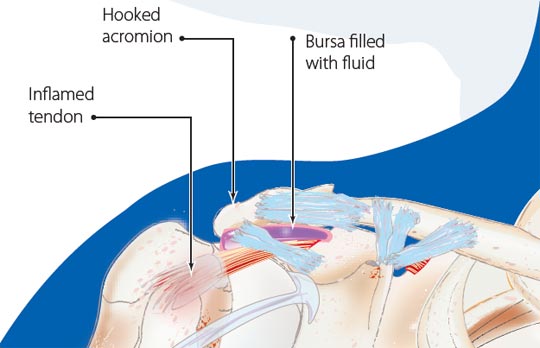Shoulder Impingement
Shoulder impingement refers to mechanical compression and/or wear of the rotator cuff tendons. The rotator cuff is actually a series of four muscles and tendons connecting the scapula (shoulder blade) to the humeral head (upper part of the arm bone). These muscles are located deep in the shoulder, beneath the deltoid muscle that gives your shoulder its contour. The rotator cuff is important in maintaining the upper arm bone within the socket during normal shoulder function and also contributes to shoulder strength during activity. Normally, the rotator cuff glides smoothly when moving. Any process that compromises the gliding function of the rotator cuff is known as shoulder impingement.
Causes of Shoulder Impingement
Common causes of shoulder impingement include weakening and degeneration within the tendon due to aging, the formation of bone spurs and/or inflammatory tissue within the space above the rotator cuff (subacromial space), and overuse injuries. Activities that can lead to impingement most commonly involve repetitive overhead motion. This is typically seen in such things as painting, carpentry, tennis, baseball, swimming, etc.
Symptoms of Shoulder Impingement
Patients with impingement most commonly complain of pain, pinching, and stiffness in the shoulder, which is worse with overhead activity and sometimes severe enough to cause awakening at night.
The diagnosis of shoulder impingement can usually be made with a careful history and physical exam. Manipulation of the shoulder in a specific way by your doctor will usually reproduce the symptoms and confirm the diagnosis. X-rays are also helpful in evaluating the presence of bone spurs and/or the narrowing of the subacromial space (the area above the rotator cuff). MRI (magnetic resonance imaging), a test that allows visualization of the rotator cuff, may be used to rule out more serious diagnoses such as rotator cuff tears

How to Treat Shoulder Impingement
As with any injury, your doctor will be the best source of advice on the appropriate treatment method for your situation. The first step in treating shoulder impingement is eliminating any identifiable cause or contributing factor. This may mean temporarily avoiding overhead activities like tennis, pitching or swimming. A non-steroidal anti-inflammatory medication, such as aspirin or ibuprofen, may be helpful in alleviating pain and swelling. Your doctor may recommend physical therapy exercises to restore normal flexibility and strength to the shoulder, including strengthening both the rotator cuff muscles and the muscles responsible for movement of the shoulder blade. An injection of cortisone into the subacromial space is often helpful in treating shoulder impingement.
Surgery is not necessary in most cases of shoulder impingement. If symptoms persist despite adequate non-operative treatment, surgical intervention may be beneficial. Surgery involves debriding, or surgically removing tissue that is irritating the rotator cuff. This is typically done with arthroscopic shoulder surgery techniques that are minimally invasive. After surgery patients use a sling for comfort, but may begin using the arm for everyday activities as soon as pain allows. Complete recovery may take 3 months.

Support and Protect for Shoulder Impingement
View Shoulder Impingement Braces
-
 $163.99On Sale 0% Off Save $0.00(10) ReviewsStabilize, protect, and perform with the Saunders Sully Shoulder Support — trusted by athletes worldwide. Ideal for dislocations, strains, and post-op recovery with dynamic support and full range of motion. Buy now for unmatched shoulder stability and all-day comfort!
$163.99On Sale 0% Off Save $0.00(10) ReviewsStabilize, protect, and perform with the Saunders Sully Shoulder Support — trusted by athletes worldwide. Ideal for dislocations, strains, and post-op recovery with dynamic support and full range of motion. Buy now for unmatched shoulder stability and all-day comfort!












